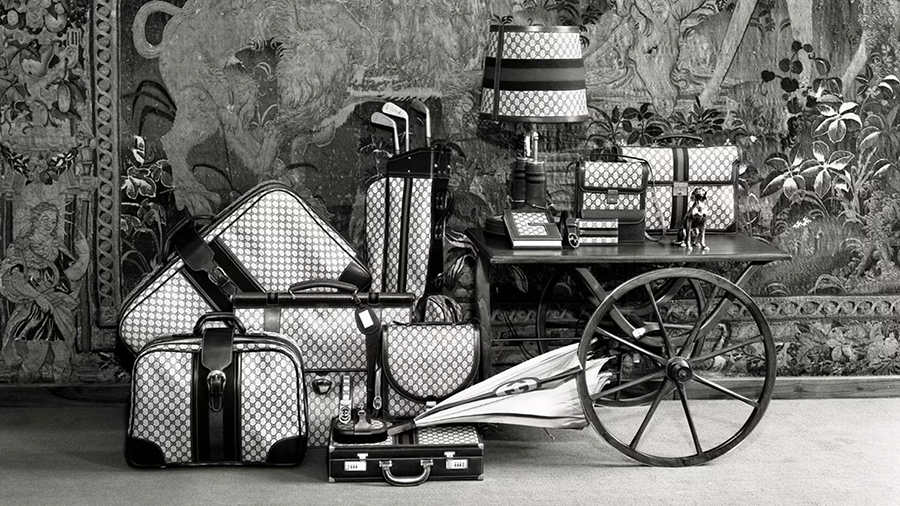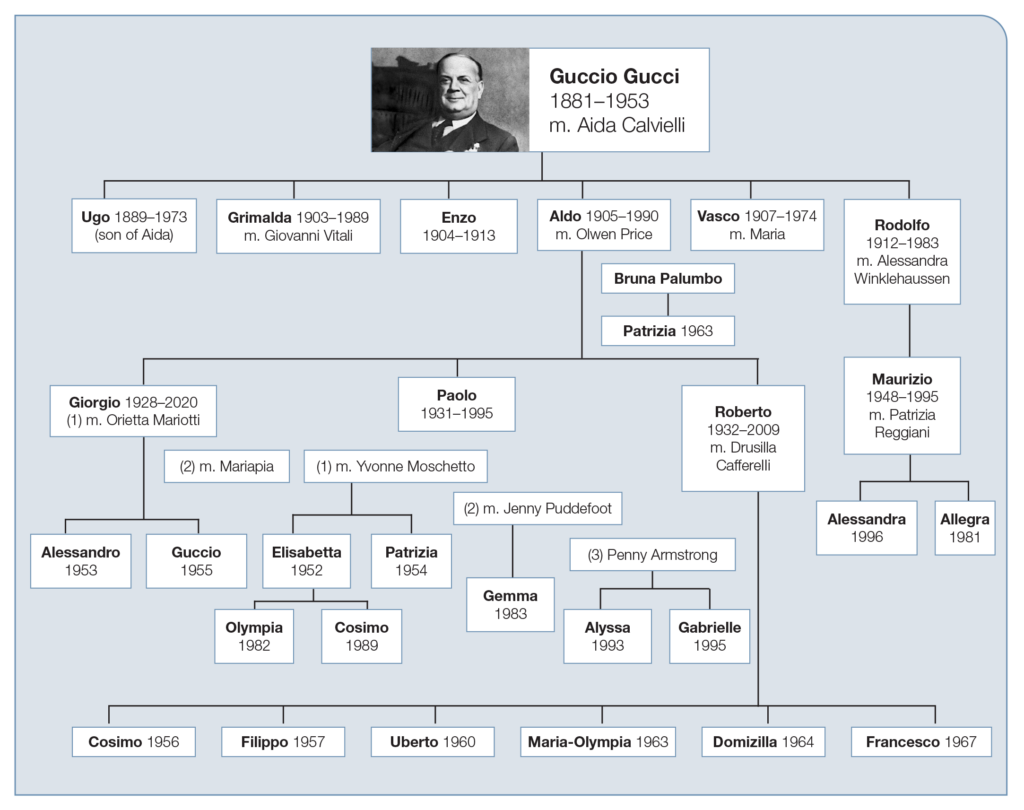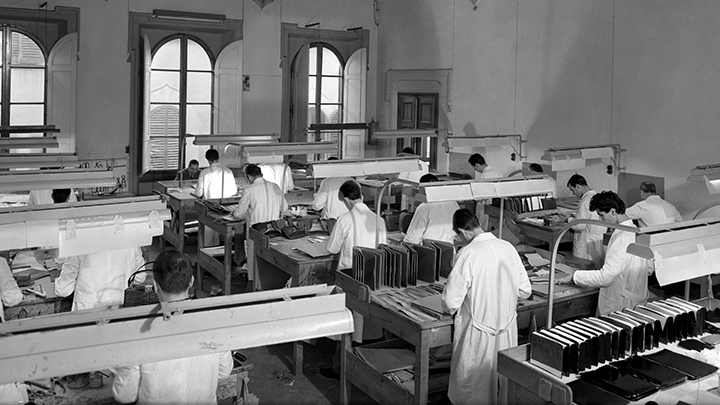Creaghan McConnell Gould takes pride in supporting Canadian business families while recognizing the value of looking beyond our borders to international business families. In part one of our Gucci series, we explore the successes and challenges to uncover insights on adaptation, succession, and legacy that can inspire and inform business families in their evolving landscapes.
“There is only one Gucci. There is only one Gucci,” Maurizio repeated to himself as he stood over his uncle Aldo’s coffin at the head of a Roman church in 1990.¹ Some people could interpret these words as Maurizio’s way of grieving the loss of his uncle. But anyone who knew anything about the Guccis knew this: Every family member thought they were the only Gucci.
What started as Guccio Gucci’s vision of Italian luxury — inspired by his days as a luggage porter at London’s famous Savoy Hotel — quickly became a cautionary tale littered with deceit, fraud, and murder. Three generations of a family managed to make Gucci the most sought-after luxury brand and empire. But, over a few decades, they lost it all. Today, Gucci is owned by Kering, a multinational holding company based out of France.

Patrizia Reggiani’s scandalous murder of Maurizio Gucci in 1995 eclipsed the family’s internal disputes. Since the conception of the brand itself, the Gucci family’s journey was paved with conflicts stemming from a lack of communication between family members, undefined roles and responsibilities, and little to no planning.
What happens when a family’s ambition to build a global empire clashes with its inability to reconcile personal matters? Could the fate of the Gucci family have been different if they had nurtured their family relationships, and not only their business ambitions? The story of the Gucci family is a glamorous yet cautionary tale, echoing challenges faced by business families worldwide even today.
Family background
Guccio Gucci’s hands had been hardened by the soft leather luggage he hauled up and down hotel hallways as a porter. His fascination with this familiar Florentine leather birthed his interest in creating his own leather goods one day. He set out to learn everything there was to know about selecting hides and curing and tanning leather. With his savings from working in various leather goods factories in Italy, he opened the first ever Gucci store in Florence in 1921, a humble place compared with the glitz and glamour of the Gucci brand today.

Three of Guccio’s sons helped him run the family business: Vasco, Rodolfo, and Aldo. While Guccio trained them from a young age to understand Gucci products and the business, the sons sat quietly on their own plans for the brand. Two weeks before Guccio’s death in 1953, the sons had agreed to open a new boutique in New York City. This was against their father’s wishes to keep the Italian brand exclusive to Italy.
Vasco ran the leather factory in Florence. Rodolfo oversaw the Milan store operations. Aldo focused on expanding Gucci internationally. While this division of responsibilities was harmonious at first, things changed when Vasco unexpectedly died in 1974. Under Italian inheritance law, Vasco’s widow, Maria, received a one-third stake in the company. Guccio, nor the family, had laid out an alternative plan. Aldo and Rodolfo eventually bought Maria’s shares to retain ownership within the family.
As Aldo’s sons — Giorgio, Paolo, and Roberto — became more involved in the business, they felt that Rodolfo’s financial stake dwarfed his contributions. As a result, Aldo set out to create sub-companies to drive more earnings towards him and his sons.

Creative control and rivalries
Finding himself outside his traditional father’s shadow, Aldo laid the groundwork for turning Gucci into an internationally recognized luxury brand:
“Aldo’s mind worked double time thinking of new products, new store locations, and new merchandising strategies. He paced up and down in his office by day and in his bedroom by night, stopping only to make notes on what he needed to do… ‘He scaled the stairs of the Rome store two and three steps at a time, staff members fluttering around him.’ […] Mercurial and intense, Aldo could be alternately a warm, paternal caretaker or a tough, domineering tyrant.”²
In contrast, Rodolfo’s artistic interests tethered him to a more conservative approach that protected Gucci’s Italian heritage. Due to a lack of succession or wealth ownership/transfer planning, Vasco’s death propelled Aldo and Rodolfo into a full-blown power struggle. A tug of war also began within G3. As Aldo’s son Paolo got more involved with the creative operations at Gucci, he began to butt heads with his uncle Rodolfo, the longstanding creative authority. In response, instead of clearly delineating the creative responsibilities within the operation, Aldo invited Paolo to work with him in New York.
These attempts at peacemaking would soon come to haunt Aldo. Unresolved conflict seeped into the Gucci foundation like mould, damaging the family and the business from the inside out. While these earlier skirmishes seem like child’s play in comparison to the battles that would follow, one can’t help but notice the mistakes that paved the way.
Important conversations failed to happen. Rodolfo deeply resented Aldo for his decision to invite Paolo to New York without telling him first. Paolo directly reported to Rodolfo in Florence. With no family consensus on conflict resolution, Rodolfo fought fire with fire and delivered a formally written letter to Paolo, informing him that he’d been fired from Gucci for failing to fulfil his creative duties back in Florence. What Rodolfo failed to mention was that he was ushering in his own son, Maurizio, from whom he had been estranged since Maurizio married his lover, Patrizia. Introducing Maurizio back into the family and, thus, the company, was Rodolfo’s way of keeping his foot firmly in the door of a company he felt he was being pushed out of.
“You must fight Paolo with everything you have got,” Rodolfo confided to Maurizio privately. “He must be defeated, utterly and quickly. He is threatening everything we have and I will not be here forever.”³
Ushering in the rising generation
Often finding himself crushed under the rigidity of his father and the outlandish fantasies of his wife, Patrizia, Maurizio was handed the keys to a castle furnished with complications. Inexperienced and insecure, he struggled to find his place in the business while carrying a 50% stake in the company on his back.
“Rodolfo’s biggest mistake was not to trust Maurizio earlier on,” said Maurizio’s advisor, Gian Vittorio Pilone, in an interview in 1999, as captured in Sara Gay Forden’s book about the family.⁴
Following Rodolfo’s death, Aldo assured his nephew that the Gucci mission remained the same: keeping the business within the family. What Aldo failed to share was how that would happen. Yet again, the Guccis embarked on a journey with no map and no compass. Since Maurizio’s own father failed to include him in the business earlier in his life, the unsure Maurizio sometimes followed the lead of his uncle. And when Maurizio felt a lack of direction or too much pressure from Aldo, he took the path of a contrarian.
When rising generation family members are left on the sidelines for too long, it can result in confusion, withdrawal, and — in the case of Maurizio — rebellion. Advisors determined to help each generation of the family and maintain relevance must actively build relationships with the rising generation long before a transition occurs, not when it’s already underway. Inclusion, trust, and preparation don’t just happen overnight — they are nurtured over time.
The rising generation takes the wheel
Meanwhile, frustrated by back-to-back blockades on his creativity and an inability to explore his own interests with the Gucci brand, Paolo tipped off the IRS about Aldo’s tax evasion in the U.S. 81-year-old Aldo served just over a year in prison in Florida. And, with that, the Gucci business was in the hands of G3, and G3 only.
As the Gucci family’s story unfolded in the papers, it seemed that the more stores they opened, the worse their family conflict became. When it comes to business, growth and revenue usually indicate success. But, in the case of family business, the Gucci family proved that this isn’t always true.
Guccio Gucci’s sons ran their business plans rampant shortly before their father died. As soon as Rodolfo passed, Maurizio did the same. Would the Gucci brand still be a family business today if family members had communicated with each other more openly, honestly, and respectfully? Had a succession plan and an estate plan been established, would family members have suffered less for their shares? Had the Gucci family’s advisors built lasting relationships with the rising generation prior to the succession, could the advisors have prevented the family from squandering their family brand?
Matt Mammola, a Family Capital Advisor at CMG, offers a few more valuable questions that all business families should explore:
- Does your family have a “Plan A”: What happens in the long run, assuming everything goes as expected? And also a “Plan B”: What happens if a major, unexpected event occurred yesterday?
- Do the family’s current plans provide clear roles and boundaries, and an orderly sharing of responsibility, or are they likely to create uncertainty and/or power struggles?
- Is there unresolved conflict among family members that will only deepen over time, or is there a healthy avenue for open communication and conflict resolution that prevents escalation?
The Gucci family’s story highlights valuable lessons for every business family in the most dramatic and glamorous way possible. While the family has already faced tragedy in the form of familial deaths and imprisonment, there’s more to come. As Maurizio takes the helm of Gucci, the next chapter of this story unfolds, which we’ll explore in part two of this series.
References:
[1] Forden, Sara Gay. 2001. House of Gucci: A Sensational Story of Murder, Madness, Glamour, and Greed. Custom House.
[2] Forden, 2001.
[3] Forden, 2001.
[4] Forden, 2001.
Noor Choudhry is a writer and a Content Specialist at Creaghan McConnell Gould.
Download and read this story as a PDF here.
